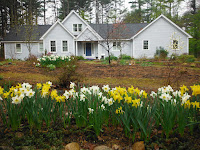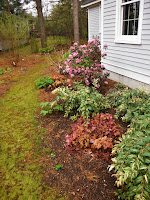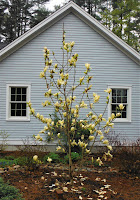The gardening world is rich with mnemonics;
simple rhyming catchphrases that help you remember important rules. How
much sunlight does a vegetable need? “Leaf, root, flower, fruit” tells
you everything you need to know. ‘Leaf’ vegetables like lettuce need the
least light, ‘fruit’ ones need most.
 |
The daffodils we planted by the road
at the front of our house have doubled |
The one I’m pondering at the start of the 2019
gardening season is “sleep, creep, leap”. It’s a powerful truth: yielding
to the desire for ‘instant gratification’ is never in a gardener’s best
interest. Instead, cultivate patience.
If you plant a tree, shrub, or perennial, expect that its first year
will be one of little apparent growth – it sleeps. Whatever you put in
the ground is busy establishing a root system and acclimating itself to a new,
alien environment.
Twelve months pass. That yearling plant creeps. It almost
grudgingly displays a modicum of visible growth, but there is still a painful,
yawning space between it and its nearest brethren. It is not until the
third – or even fourth year – that the plant begins to fill its appointed
space, and a garden begins to look like, well, a garden.
 |
The leucothoe, heuchera,
and azalea now fill the bed |
It is also in that second year that
Type-A-personality gardeners fall into the trap of overbuying and over-planting.
If a rhododendron’s tag says to plant specimens four feet apart, the impatient gardeners
shrinks that spacing to three or even two feet. For a year or two, the
homeowner achieves the illusion of an ‘instant garden’. By the third year,
plants are getting in one another’s way. By the fifth year, shrubs that
ought to be healthy are instead dying of diseases that should be collectively
be labeled, ‘willful ignorance’. (Several
decades ago, we acquired a house with such a landscape. A year into our ownership, we pulled our
hundreds of dollars of yellowing shrubs with underdeveloped roots starved for
space.)
Betty and I moved into our new home in early
April 2015. Our intention had been to quickly install some 200 perennials
lovingly divided and potted up from our ‘old garden’ and bring in a full
retinue of new trees and shrubs perfect for the site. Long before the
first frost, we would have the elements of our new garden on the half-acre (of
our one-and-a-half acres) we planned to cultivate.
 |
Magnolia 'Elizabeth' went
from a few dozen blooms
to more than a hundred |
It took until mid-summer to complete the site
preparation; nothing went into the ground during the critical April through
June period. By the end of September, we had planted just eight trees, 50
or so perennials, and perhaps a dozen shrubs.
We added 1800 bulbs in late October. Our start was so late that
2015 didn’t even merit being called the ‘sleep’ phase; most of the plants we
wanted were still in nurseries.
 |
The hyacinths we planted along the
sidewalk emerge stronger each year |
In the following two years we added more trees
and several dozen shrubs. We began planting ground covers, added plants
–primarily native perennials – to the spaces between trees and shrubs. And,
yes, more bulbs went into the ground, bringing our total to more than
4,000. Those were our ‘sleep’ years.
I remember looking out on our back patio where we had planted more than a
hundred native perennials a year earlier. I kept thinking that, by now, it
ought to be a scene of riotous color and texture. Instead, it was a
series of discrete, small plants. Nothing touching, much less overlapping.
Our ‘creep’ year was 2018. The ‘ephemerals’ – especially the Virginia
bluebells – flowered and proliferated. Our hostas unfurled their first leaves before
the end of April. The dicentra grew vigorously and bloomed into July. Our
shrubs – notably the small iteas and fothergillas – put up exuberant spikes of
white flowers, and our leucothoes nearly doubled in size.
 |
The individual plugs of
bearberry have merged into
a mat, helping prevent weeds |
This spring we are seeing the telltale signs
that 2019 is our ‘leap’ year. The dozen
plugs of bearberry we planted in 2016 merged over the winter into a continuous
cover that will help keep weeds under control in one section of the garden. Eight, gallon pots of chrysanthemum daisies
planted on three-foot centers in 2017 will merge this season into a continuous
mass of long-blooming color. A handful
of native asters we planted in 2016 to help keep soil in place at the edge of
our wetlands have proliferated to the point we now need to stop their plan for
world dominance.
It is the trees and shrubs, though that provide
the greatest satisfaction. Only a year
ago, our yellow magnolia ‘Elizabeth’ had scarcely two dozen blooms in late
April. This morning I stopped counting
at a hundred. We planted many of our
native shrubs in groups of three, typically on four-foot centers. As they begin greening up this year, it is growing
difficult to know which branches below to what shrub.
The best news is that the ‘leap’ phase is not
just a one-year event. Rather, it is the
first tangible – and continuing – evidence of our land’s evolution from a ‘collection
of plants’ into a coherent garden.

